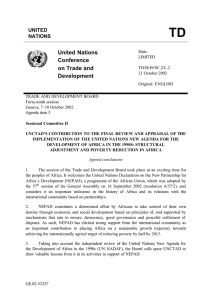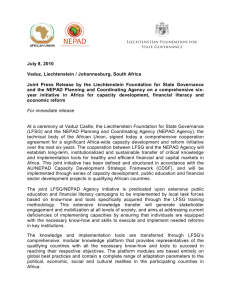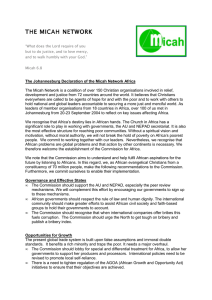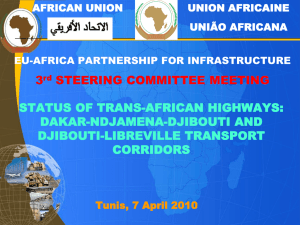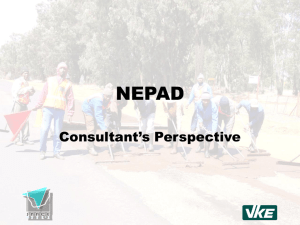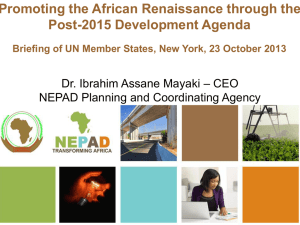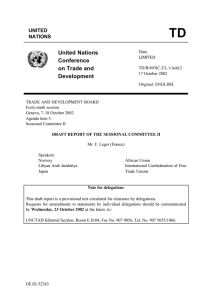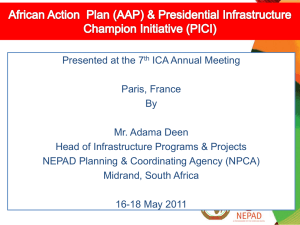Working Paper THE NEW PARTNERSHIP FOR AFRICA'S DEVELOPMENT (NEPAD): AN INITIAL COMMENTARY
advertisement
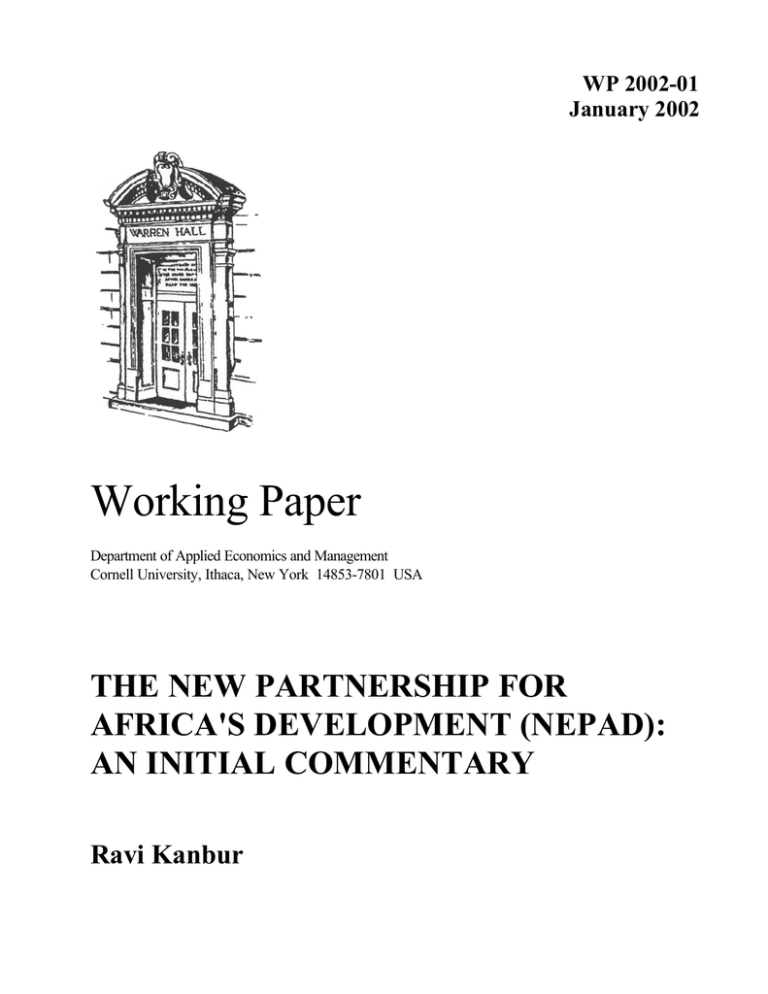
WP 2002-01 January 2002 Working Paper Department of Applied Economics and Management Cornell University, Ithaca, New York 14853-7801 USA THE NEW PARTNERSHIP FOR AFRICA'S DEVELOPMENT (NEPAD): AN INITIAL COMMENTARY Ravi Kanbur It is the Policy of Cornell University actively to support equality of educational and employment opportunity. No person shall be denied admission to any educational program or activity or be denied employment on the basis of any legally prohibited discrimination involving, but not limited to, such factors as race, color, creed, religion, national or ethnic origin, sex, age or handicap. The University is committed to the maintenance of affirmative action programs which will assure the continuation of such equality of opportunity. THE NEW PARTNERSHIP FOR AFRICA’S DEVELOPMENT (NEPAD): AN INITIAL COMMENTARY by Ravi Kanbur* Cornell University http://www.people.cornell.edu/pages/sk145 sk145@cornell.edu First Draft: November, 2001 Minor changes: December, 2001 Contents 1. 2. 3. 4. 5. 6. * Introduction The Structure and Content of NEPAD An Initial View Comparative Advantage, Poverty, and the Four Domains of Policy Application of the Framework Conclusion T.H. Lee Professor of World Affairs and Professor of Economics, Cornell University. This commentary was prepared at the invitation of the Southern African Regional Poverty Network. I am grateful to Richard Humphries of SARPN for the invitation. The analytical foundations for this commentary are to be found in a number of papers I have written over the last few years. See, in particular, Ravi Kanbur, “Cross Border Externalities, International Public Goods and Their Implications for Aid Agencies,” 2001, http://www.people.cornell.edu/pages/sk145/papers/IPGWB.pdf; Ravi Kanbur and Lyn Squire, “The Evolution of Thinking About Poverty: Exploring the Interactions,” in G. Meier and J. Stiglitz (eds.), Frontiers of Development Economics: The Future in Perspective, Oxford University Press 2001, http://www.people.cornell.edu/pages/sk145/papers/evolution_of_thinking_about_poverty.pdf; Ravi Kanbur, “Economic Policy, Distribution and Poverty: The Nature of Disagreements,” World Development, June 2001, http://www.people.cornell.edu/pages/sk145/papers/Disagreements.pdf; Ravi Kanbur, "Aid, Conditionality and Debt in Africa,” in Finn Tarp (ed), Foreign Aid and Development: Lessons Learnt and Directions for the Future, Routledge, 2000, http://www.people.cornell.edu/pages/sk145/papers/africaid.pdf; and Ravi Kanbur, "Income Distribution and Development,” in A.B. Atkinson and F. Bourguignon (eds.) Handbook of Income Distribution, Vol 1, North Holland, 2000, http://www.people.cornell.edu/pages/sk145/papers/Income1.pdf. I have also benefited from reading Stephen Gelb’s recent paper, “South Africa’s Role and Importance in Africa and for the Development of the African Agenda,” The Edge Institute, October, 2001. The NEPAD document is being updated continuously. The version on which this commentary is based is dated October 2001, and is available at http://www.hsrc.ac.za/corporate/conferences/sarpn/primaryMaterial/NEPAD.html. 1. INTRODUCTION The New Partnership for Africa’s Development (NEPAD) was born on October 23, 2001, in Abuja, Nigeria. The Implementation Committee of Heads of State, chaired by President Obasanjo of Nigeria, adopted the revised NEPAD document (October 2001 edition) as the original text “embodying the philosophy, priorities and implementation modalities of the Initiative.” The name of the initiative, hitherto called the New African Initiative (NAI) was changed to NEPAD. NEPAD will rapidly be given an institutional structure and resources, with a secretariat located in Pretoria, South Africa. According to the communiqué released after the inaugural meeting of the Implementation Committee, preparations are under way to develop specific programs and projects, and to develop proposals for a conference on financing NEPAD, to be held in Dakar, Senegal, in January 2002. This commentary attempts to advance the discussion on NEPAD by proposing a framework in which such regional initiatives might be assessed, with the twin guiding principles of (i) comparative advantage (ii) poverty reduction. That the NEPAD is a regional initiative, and that its objective is poverty reduction, is made abundantly clear in the opening line of the NEPAD document: “This new African initiative is a pledge by African leaders, based on a common vision and a firm and shared conviction, that they have a pressing duty to eradicate poverty and to place their countries, both individually and collectively, on a path of sustainable growth and development, and at the same time to participate actively in the world economy and body politic.” It is hoped that the framework presented here will be useful as NEPAD is refined through debate and discussion, and through the lessons of implementation. The outline of the rest of this paper is as follows. Section 2 contains a rapid overview of the key elements of NEPAD to give a flavor of the nature of the initiative. Section 3 then presents an initial commentary, highlighting the main strengths of NEPAD and the challenges it faces in the way it has been conceptualized. Section 4 offers a framework for assessing NEPAD in terms of the twin guiding principles and their operation in four domains of policy—global, regional, national and local. Section 5 applies this framework in illustrative manner to some of the actions proposed under NEPAD. Section 6 concludes the commentary. 2 2. THE STRUCTURE AND CONTENT OF NEPAD The basic document of NEPAD derives from an earlier document, “A New African Initiative (NAI)”, itself a merger of two parent documents, “The Millennium Partnership for the African Recovery Programme (MAP)”, and the “Omega Plan.” The NEPAD document starts with three opening sections which introduce the document, and set the stage by reviewing the place of Africa in today’s world, and stating the new political will and resolve of African leaders in the context of the spread of democracy. It then moves rapidly to set out the strategy, to a discussion of programmes of action, and to an implementation plan. As stated in the NEPAD document, the African “Strategy for Achieving Sustainable Development in the 21st Century,” has the following structure: Conditions for Sustainable Development A1. Peace, Security, Democracy and Political governance A2. Economic and Corporate Governance A3. Sub-regional and Regional Approaches to Development A. B1. B2. B3. B4. B5. B6. Sectoral Priorities Infrastructure Human Resource Development Agriculture Environment Culture Science and Technology Platforms B. Mobilizing Resources C1. Capital Flows C2. Market Access The Programme of Action picks up the themes and develops them, but the discussion is at a fairly general level. As an illustration, the actions proposed under Economic and Corporate Governance are as follows: • A Task team from Ministries of Finance and Central banks will be commissioned to review economic and corporate governance practices in the various countries and regions, and make recommendations on appropriate standards and codes of good practice for consideration by the Heads of State Implementation Committee within six months. 3 • • • The Implementation Committee will refer its recommendation to African states for implementation. The Implementation Committee will give high priority to public financial management. Countries will develop a programme for improving public and financial management and targets, and assessment mechanisms will also be set. The Heads of State Implementation Committee will mobilize resources for capacity building to enable all countries to comply with the mutually agreed minimum standards of codes of good practice. Under Sectoral Priorities, Human Resource Development, for example, is further divided into three sub initiatives: Poverty Reduction, Education, Reversing the Brain Drain, and Health. The actions under Poverty Reduction are stated as follows: • • • • Require that country plans prepared for initiatives in this programme of action assess their poverty reduction impact, both before and after implementation. Work with the World Bank, the International Monetary Fund (IMF) and the United Nations (UN) agencies to accelerate implementation and adoption of the Comprehensive Development Framework, the Poverty Reduction Strategy and related approaches. Establish a gender task team to ensure that the specific issues faced by poor women are addressed in the poverty reduction strategies, of the New Partnership for Africa’s Development. Establish a task team to accelerate the adoption of participatory and decentralized processes for the provision on infrastructural and social services. As another illustration of the sub-sectoral strategy, here are the actions under the Information and Communications Technology Initiative, which falls under Infrastructure: • • • • • Work with regional agencies such as the African Telecommunications Union and Africa Connection to design model policy legislation for telecommunications reform, and protocols and templates for e-readiness assessments. Work with the regional agencies to build regulatory capacity. Establish a network of training and research institutions to build high-level manpower. Promote and accelerate existing projects to connect schools and youth centres. Work with development finance institutions in Africa, multilateral initiatives (G-8 DotForce, UN Task Force) and bilateral donors to establish financial mechanisms to mitigate and reduce sector risks. 4 The Mobilizing Resources part of the strategy is subdivided into the Capital Flows Initiative—which is further subdivided into increasing domestic resource mobilization, debt relief, ODA reform and private capital flows—and Market Access. As a final example that gives a flavor of the content of the NEPAD document, the actions under the Private Capital Flows Initiative are: • • • • • Establish a task team to a carry out audits of investment-related legislation and regulation, and with a view to risk reduction and harmonization within Africa. Carry out a needs assessment of and feasibility study on financial instruments to mitigate risks associated with doing business in Africa. Establish an initiative to enhance the capacity of countries to establish PPPs. Establish a Financial Market Integration Task Force that will serve to fast-track financial market integration through the establishment of an internationally competitive legislative and regulatory framework and the creation of a single African trading platform. Additional debt relief and ODA. The above brief illustrations of the content of the NEPAD should give a sense of how it is conceptualized and structured, the range of issues it covers, and the level of specifics in it. We turn now to an initial commentary on the document. 3. AN INITIAL VIEW The NEPAD initiative is to be welcomed wholeheartedly. While recognizing the historical and colonial roots of African underdevelopment, NEPAD argues that Africa’s future is in its own hands—“the hopes of Africa’s peoples for a better life can no longer rest on the magnanimity of others.” It candidly recognizes that past attempts “to set out continent-wide development programmes” have not succeeded, in part because of “questionable leadership and ownership by Africans themselves.” It welcomes the fact that “across the continent, democracy is spreading, backed by the African Union (AU), which has shown a new resolve to deal with conflicts and censure deviation from the norm.” It states clearly that “The New Partnership for Africa’s Development has, as one of its foundations, the expansion of democratic frontiers and the deepening of the culture of human rights.” Finally, while the financial importance of concessional external resources is recognized, it is done so in the framework of partnership between equals. 5 These overarching features of NEPAD, in particular its strong emphasis on democracy and governance, do indeed make it different from past attempts at fashioning Africa-wide initiatives for African development. However, it shares other features with past efforts that are perhaps inevitable in a wide-ranging document. Two related characteristics that stand out are its broad spread and the level of generality at which actions are discussed. Thus the document declares that “African leaders will take joint responsibility for the following: -Strengthening mechanisms for conflict prevention, management and resolution at the sub-regional and continental levels, and to ensure that these mechanisms are used to restore and maintain peace; -Promoting and protecting democracy and human rights in their respective countries and regions, and by developing clear standards of accountability, transparency and participatory governance at the national and sub-national levels; -Restoring and maintaining macroeconomic stability, especially by developing appropriate standards and targets for fiscal and monetary policies, and introducing appropriate institutional framework to achieve these standards; -Instituting legal and regulatory frameworks for financial markets and auditing of private companies and the public sector; -Revitalising and extend the provision of educational, technical training and health services, with high priority given to tackling HIV/AIDS, malaria and other communicable diseases; -Promoting the role of women in social and economic development by reinforcing their capacity in the domains of education and training; by the development of revenuegenerating activities through facilitating access to credit; and by assuring their participation in the political and economic life of African countries; -Building the capacity of states in Africa to set and enforce the legal framework, as well as maintaining law and order; -Promoting the development of infrastructure, agriculture and its diversification into agro-industries and manufacturing to serve both domestic and export markets.” This list should give some idea of the scope envisaged for NEPAD. The generality of the actions under each program or initiative has already been suggested in the previous section. Yet it can be argued that such a characterization is unfair, for two reasons. First, an 6 Africa-wide program such as NEPAD is bound to be general in nature. The continent’s problems are themselves broad and interlinked. Second, the document does in fact suggest prioritization. It does so implicitly by the order in which the key issues are listed—conflict prevention, democracy and governance are clearly seen as being of primary importance. Also, in the concluding sections, the document does discuss immediate priorities and “fasttracking”: “Recognising the need to sequence and prioritize, the initiating Presidents propose that the following programmes be fast-tracked, in collaboration with development partners: (a) (b) (c) (d) Communicable diseases—HIV/AIDS, malaria and tuberculosis; Information and Communications Technology; Debt reduction; Market access.” However, it is not clear how exactly these or other priorities are developed, and it is equally not clear how to evaluate specific actions within each of the priority areas. As the discussion of NEPAD develops, as it moves into the implementation phase, and as demands on its limited resources multiply, there will need to be a framework in which priorities and specifics are assessed. The next section offers a particular framework to initiate the debate. 4. COMPARATIVE ADVANTAGE, POVERTY AND THE FOUR DOMAINS OF POLICY How is one to prioritize among the large number of actions and interventions that could potentially fall under the rubric of NEPAD? This section considers two governing principles: the comparative advantage of NEPAD in carrying out specific actions, and the impact of those actions on poverty. The comparative advantage of NEPAD stems directly from its origins and status as a Regional institution with roots in African democracies. These twin features determine the level at which the institution is most likely to be effective, and the issues on which it is likely to have greatest credibility. Thus issues for which an Africa wide perspective emanating from democratically elected African leaders is essential, are likely to be the issues on which 7 NEPAD has a comparative advantage relative to the many other institutional arrangements which already exist in Africa. On poverty, it is suggested here that direct versus indirect impacts of actions is a useful distinction. Relatedly, short run versus long run consequence for poverty is another useful categorization. There are many actions which reduce poverty indirectly and in the long run, as the economy as a whole develops and prospers. Infrastructure investment that promotes high technology manufacturing, is an example of this. And there are actions that can have a faster and more direct beneficial effect on the poor. Direct investment in health facilities in poor areas, or the development of an effective anti-malaria vaccine, are examples of this. There may also be tradeoffs. Actions and interventions which lead to long-term development and poverty reduction may nevertheless have short-term adverse consequences for some of the poor. Infrastructure investment like dams, or some forms of trade liberalization, provide examples of these painful tradeoffs. Everything else being equal, the position taken here is that actions which have most direct and beneficial impacts on poverty should be prioritized. To illustrate the operation of these two principles, the framework can be further developed by considering four domains of the operation of policy and of its impact—Global, Regional, National and Local. By the global domain is meant the constellation of policies and impacts at the level above the region, and where decisions are, or ought to be, made at the global level. Global warming, the Law of the Seas, international financial architecture, research into malaria vaccine, and WTO are examples of issues that fall under this category. The regional domain is Africa-wide. Africa’s trade preferences with the EU, or Africa’s response to the US African Growth and Opportunity Act, cross-national issues within Africa like water rights or infrastructure, or regional trade agreements and, most crucially, peace and security within Africa, are all in the regional domain. The national domain is the one most commonly discussed—exchange rate policies, sound public finances, trade liberalization, privatization, the budget for education and health, a well functioning legal system, democratic governance and a free press are all examples of levers that operate essentially at the national level. Finally, the local level is sub-national, going right down to the community, the household and the individual. Household decisions such as sending girl children to school, choosing cash crops versus food crops, or community decisions such as how much labor to contribute to 8 repairing culverts, or on how to manage common property resources such as fish ponds or wood lots, are examples of the issues that define the local domain. Of course, like any classification, the Global-Regional-National-Local (GRNL) framework is not completely tight and well defined. Thus, for example, the regional domain includes strictly region-wide issues as well as issues which may be more properly classified as sub-regional—indeed, Africa has many sub-regional organizations such as ECOWAS or SADC. In the GRNL framework these are all subsumed under R. Similarly, as noted above, the local domain stretches from the nation, through sub-national entities, to local communities to households and individuals. There are overlaps as well. For example, while the operations of WTO can be classified under the global realm, if Africa were to take a unified stance on a negotiating position that would be a regional level decision but one with a global impact as well as an impact on the region. Similarly, local communities and organization do not operate independently of the national legal structure, so the L and N domains overlap and interact. These overlaps and interactions across the GRNL domains will have to be kept in mind, and indeed will be an interesting part of the analysis. But ultimately the framework’s usefulness will have to be judged in terms of the insights it provides in structuring discourse on NEPAD and poverty. The basic definitions and characterizations of poverty all fall in the local domain. This is not the place to review the huge and evolving literature on the conceptualization and measurement of poverty. The last quarter century has seen a progressive broadening of the characterization from low income to inadequate achievements in education, health and nutrition. Most recently, the additional conceptualization of poverty as vulnerability (to events outside the control of the individual or the community) and voicelessness (in the face of unresponsive local and national institutions) has also entered the discourse. But all of these focus on the individual, the household or the community. The moral weight of the concept of poverty comes from its direct link to human beings and their well-being, rather than the state of larger entities and statistical abstractions. The ultimate focus of policy in the global, regional and national domains must therefore always be its impact, directly or indirectly, on the poor at the local level. The issue of direct and indirect impacts also cuts across the GRNL classification. Policies and forces at the global level can impact the poor directly, or indirectly through their 9 consequences for the regional or national level. For example, an international breakthrough in developing a vaccine for malaria has the potential for a direct impact on the well being of the poor in Africa. But an international financial architecture which leads to a more stable global trade and payments system will work more indirectly, hopefully through stimulating economic growth at the regional and national levels. Similarly, cross-regional cooperation on river blindness has had major direct impact on the health of Africa’s poor at the local level. Agreements that bring peace and security to war torn countries have a direct consequence for the poor. But they also have an indirect effect as the stability lays the basis for national economic growth. For those countries not mired in civil war, national level policy such as the sectoral composition of public expenditure—for example, whether it is targeted towards poor regions and poor households—is a key determinant of poverty impact. Macroeconomic and trade policy works more indirectly, by creating the environment for private investment and growth. At the same time, some macroeconomic and trade policies at the national level, while promoting growth and poverty reduction in the medium term, may have short-term adverse consequences for the poor. As noted earlier, NEPAD’s comparative advantage is that it is a regional institution speaking with an authority rooted in democratically elected governments. Its regional character locates it squarely in the R domain of our four-fold classification. It follows that its natural niche is in policies and interventions that apply in the regional domain, and those in other domains for which having a united African voice is particularly important. Examples that come to mind are (i) regional peace and security initiatives (R), (ii) regional level infrastructure or environmental investments (R), (iii) a united African position on international financial architecture, WTO and debt relief (G), (iv) pressing for global research on tropical diseases (G), (v) peer monitoring and pressure on governance and rule of law in African nations (N) and (vi) establishing and pushing for “best practice” standards in public expenditure management (N). However, while all of these examples make use of NEPAD’s regional nature, only a few of them benefit particularly strongly from the second feature of NEPAD—its credibility as an initiative in which democratic governance is “one of the foundations.” Of the examples given above, it can be argued that only (i) and (v) make particularly strong use of the democratic basis of NEPAD. 10 Moreover, each action with an impact in the R, G or N domain, which is where NEPAD’s actions are likely to be most effective, has also to be assessed for its efficacy for poverty reduction—directly, and indirectly. Thus, for example, regional peace and security has a direct and immediate impact on the wellbeing of the poor since they are the ones most negatively affected by insecurity. It also has an indirect and medium term effect because security establishes the conditions for investment and growth. Relatedly, once basic peace and security is in place, the legal and police system, and governance more generally, has an immediate impact on the lives of the poor, as well as improving the climate for private sector investment for medium term growth. The same is true, in the G domain, of global investments in vaccine research, or international debt relief (although for both of these to work national level governance has to be appropriate). However, regional level infrastructure investments, while crucial from the medium term point of view, may only have minor effects on poverty in the short term. Similarly, improving the global climate for investment, important over the medium term for global growth and hence growth in Africa, may not pay immediate dividends for the poor. The above illustrative discussion suggests three key questions that should be asked of any set of actions or program proposed under the NEPAD umbrella, as an aid to establishing priorities: (i) Is the program particularly well suited to a regional organization, and are there not other regional organizations that are already doing it reasonably well? (ii) Is the program particularly well suited to a regional organization that is rooted in democratic values? (iii) Does the program combine both direct and indirect benefits to the poor? Programs and actions which score high on these criteria should be prioritized. The next section illustrates the application of these criteria by considering individual actions discussed in the NEPAD document. 11 5. APPLICATION OF THE FRAMEWORK We now proceed to an evaluation of the actions proposed in the NEPAD document. The evaluation will be illustrative rather than comprehensive, since the actions in the NEPAD document are themselves meant to be initial statements for further elaboration and discussion. The broad structure of the NEPAD proposals has been outlined in Section 2. It should be clear from the discussion above that the proposals under A1, the Peace and Security Initiative, score very highly on all three criteria set out. Actions are envisaged in four areas: “prevention, management and resolution of conflict; peacemaking, peacekeeping and peace enforcement; post-conflict reconciliation, rehabilitation and reconstruction; and combating illicit proliferation of small arms, light weapons and landmines.” While there is room for discussion on specifics, the actions proposed are clearly regional, they are clearly well suited to an organization emanating from democratic governments, and their direct and indirect impacts on poverty reduction are significant. It is encouraging, therefore, that the NEPAD document notes that “The leadership of the New Partnership for Africa’s Development will consider, within six months of its establishment, setting out detailed and costed measures in each of the four areas above. The exercise will also include actions required of partners, and the nature and sources of financing such activities.” The same is true of key actions under the Democracy and Political Governance Initiative. These consist of: “a series of commitments by participating countries to create or consolidate basic governance processes and practices; an undertaking by participating countries to take the lead in supporting initiatives that foster good governance; and the institutionalization of commitments through the New Partnership for Africa’s Development leadership to ensure that the core values of the initiative are bided by.” Again, there is room for discussion and perhaps disagreement on specifics, but at this level of generality these actions score high on all three criteria. But consider now actions under A2, the Economic and Corporate Governance Initiative, which were laid out in Section 2 as an illustration of the details in the NEPAD document. While there are clearly some regional dimensions of these actions, and while it is clear that good economic management is the sine qua non of medium term growth and poverty reduction, it is not immediately obvious that the actions listed are particularly suited to 12 NEPAD’s comparative advantage, nor that many of them might not be better carried out by other organizations such as the African Development Bank. It is also not clear how country specific agreements with the IFIs will interact with these region wide initiatives in economic management. At the very least, it would seem that some further debate and discussion is needed before a top priority is put on this for allocation of NEPAD’s scarce resources. Under A3, Sub-Regional and Regional approaches to development, the NEPAD document broaches actions that overlap with actions under other headings as well, but covering “Regional Public Goods”: “The New Partnership for Africa’s Development focuses on the provision essential regional public goods (such as transport, energy, water, ICT, disease eradication, environmental preservation, and provision of regional research capacity), as well as promotion of intra-African trade and investments.” While regional public goods clearly fit into the R domain of NEPAD’s comparative advantage, and thus score high on the first criterion, questions remain on (i) are there other regional organizations that are doing the job? and (ii) which of these regional public goods has a significant effect on poverty through combining positive direct and indirect impacts? Of the examples mentioned in the quote above, regional research capacity is perhaps best left to the African Development Bank, and the NEPAD document recognizes this. There are also, of course, numerous sub-regional organizations for coordinating transport and trade issues. Duplication of these efforts should be avoided. On poverty, regional efforts at vector borne disease eradication would clearly score higher on direct impact than, for example, regional transport initiatives. All of these factors must be borne in mind when prioritizing between such regional public goods. Under Sectoral priorities, NEPAD discusses a wide array of actions, all of which would be beneficial to African development but only some of which are particularly well suited to NEPAD’s comparative advantage, and would be of major immediate benefit to the poor. Rather than go through each of the actions in detail, we will merely take some examples to illustrate the application of the criteria above. Consider, for example, the array of actions under “Investing in Information and Communication Technologies,” which are listed in Section 2. The first action is to “work with regional agencies such as the African Telecommunications Union and Africa Connection 13 to design model policy and legislation for telecommunications reform, and protocols and templates for e-readiness assessment.” Since this is an area where other regional agencies are already working, the issues of NEPAD’s involvement must be scrutinized carefully to assess its priority. The second and third actions, “work with regional agencies to build regulatory capacity,” and “establish a network of training and research institutions to build high-level manpower,” are not specified in sufficient detail for evaluation. They are of course in principle plausible for a regional institution to take up. But, (i) there are other regional agencies dedicated to these tasks, (ii) it is not clear how the democratic roots of NEPAD feed in to them and (iii) the direct poverty impacts are not obvious, although indirect and medium term benefits could be substantial through growth enhancing investments in ICT. The fourth action, “promote and accelerate existing projects to connect schools and youth centers”, is very much in the N or L domain—it is not clear that it is the comparative advantage of an institution in the R domain to prioritize this. Finally, the statement of the fifth action, “work with development finance institutions in Africa, multilateral initiatives (G-8 Dotforce, UN Task Force) and bilateral donors to establish financial mechanisms to reduce sector risks,” itself highlights that there are other agencies already deeply involved, and does to clarify what exactly NEPAD as an institution could bring to the table. Many of the actions in the sectoral priorities portion of NEPAD would thus score low on the three criteria laid out above. But there are other actions that would indeed score highly. For example, health is a sub-category under B2, and the following actions are envisaged under this heading: “-Strengthen Africa’s participation in processes aimed at procuring affordable drugs, including those involving the international pharmaceutical companies and international civil society, and explore the use of alternative delivery systems for essential drugs and supplies; -Mobilise the resources required to build effective disease interventions and secure health systems; -Lead the campaign for increased international financial support for the struggle against HIV/AIDS and other communicable diseases; -Join forces with other international agencies such as the WHO and donors to ensure support for the continent is increased by at least US $10billion per annum; 14 -Encourage African countries to give higher priority to health in their own budgets and to phase such increases in expenditure to a level to be mutually determined; -Jointly mobilize resources for capacity-building in order to enable all African countries to improve their health infrastructure and management.” In this list of actions there are some for which comparative advantage of NEPAD relative to other agencies is not necessarily strong. For example, in the second proposed action, if the systems and interventions are primarily national it is not clear that a regional institution has a comparative advantage raising resources for them. Similarly, while of course improving of health infrastructure is to be welcomed as a general medium term goal, the sixth action seems like a general exhortation—it is not clear that this is a leading candidate for the scarce resources represented by NEPAD’s special comparative advantage, and there are other agencies already working on this. However, the first, third, fourth and sixth sets of actions listed above would score very highly on the three criteria. These are actions which make best use of NEPAD as a regional entity and a credible democratic voice for Africa, where it is unlikely that other Africa-wide agencies could be as effective, and where the direct and indirect impacts on the health of the poor are very great. The global debate on the prices charged by international pharmaceutical prices for key drugs is directly crucial to the well being of millions of poor people across Africa. Northern governments are under pressure from their own civil societies to enact various legislations with respect to this issue. What Africa needs in this debate is a credible voice that can represent all of Africa, and be representative of the people of Africa. NEPAD fits the bill. The allocation of resources to give NEPAD the technical support it needs in this debate would therefore get high marks on our criteria. The same is true for the campaign to increase international financial support for an attack on communicable diseases. Moreover, it is well known that a major problem in Africa is that African countries’ own health budgets are highly skewed in favor of the urban rich. NEPAD’s development and operation of an Africa wide mechanism of mutual monitoring would draw on NEPAD's twin sources of comparative advantage—its regional character and its roots in representative government. Consider now the third category of actions proposed under NEPAD, Mobilising Resources. Some care is again needed here in separating out those actions which are primarily national in nature and over which NEPAD can have little influence, or which are 15 best done by other regional agencies, and those actions which can truly capitalize on NEPAD’s comparative advantage. Let us start with C1, the Capital Flows Initiative. NEPAD, with its special authority, can play a strong role in fashioning a case for deeper and broader Debt Relief (a sub-category of actions under C1), while at the same time developing mutual monitoring mechanisms for ensuring that the proceeds of debt relief do indeed find their way directly to the poor. This is particularly true given a perception in some quarters that the international debt relief initiative is stuck at too timid a level. However, there is less of a strong case for NEPAD giving high priority to ODA issues in general (another sub-category under C1). It is not clear that the issue is sufficiently well crystallized in the international domain in such a way that NEPAD could play a special role. Other agencies such as ECA should perhaps take the lead in such issues as responses to the PRSP framework, and the NEPAD document recognizes this. On encouraging private capital flows (the final sub-category under C1), the actions suggested in the NEPAD document are all perfectly reasonable, but it is not clear that they have a priority claim on NEPAD’s scarce capital, and there are surely other agencies which have better technical expertise to carry out tasks such as reviewing investment related legislation or enhancing capacity of countries to implement PPPs. The Market Access Initiative, C2, similarly has a mix of actions that are on the face of it either very well suited to NEPAD’s comparative advantage and to the poverty reduction objective, or not as well suited. It is hard to think that NEPAD could develop sufficient sectoral expertise, for example in mining, to achieve very specific sectoral goals. Others, such as “develop new industries, or upgrade existing ones, where African countries have comparative advantages, including agro-based industries, energy and mineral resource-based industries,” seem far too general, and in any case squarely in the national domain, to not have a priority claim on NEPAD resources. However, the objective that “if a new round of multilateral trade negotiations is started, it must recognize and provide for the African continent’s special concerns, needs and interests in future WTO rules,” is clearly one in which NEPAD should take a lead role, supported by technical agencies. This is because it is important in international negotiations for Africa to speak not only with one voice but a voice that has credibility because it represents the will of the African people through democratically elected heads of state. 16 Let us finally consider, as an application of the framework developed in this paper, the programmes that the NEPAD document itself argues should be “fast-tracked”. As noted above there are four of these—Communicable Diseases, ICT, Debt Reduction and Market Access. Of these four, the framework developed here would strongly support Communicable Diseases and Debt Reduction as priorities for NEPAD. The three questions posed in the criteria set out in the previous section would be answered as follows. (i) These actions are particularly well suited to a regional organization and other regional organizations in Africa are not doing them particularly well or at all. (ii) In making a continent wide argument for debt reduction, in developing monitoring mechanisms and protocols for prudent use of the proceeds of debt relief, and for presenting and defending the interests of Africa vis a vis international pharmaceutical companies in the court of world opinion, an African organization rooted in democratic values has a special comparative advantage. (iii) Both debt relief and health advances in communicable diseases will have a direct beneficial impact on the well being of the poor, as well as indirect and medium term benefits through the overall climate for economic growth. Debt Reduction and Communicable Diseases would therefore score high on all three criteria. But the same is not true of ICT and Market Access. ICT has been discussed above. Market Access is a very large sub-category, some components of which would not score high but others, particularly those focusing on WTO and other specifically international issues where a democratic voice from Africa will be effective, would indeed be prioritized in the framework developed in this paper. 6. CONCLUSION As the implementation of NEPAD gathers steam, there will be more demands on it than can be satisfied—by a vast margin. The needs of the continent are so great, the diagnosis of the causes of African poverty are so complex and so interlinked, and the financial and technical resources of NEPAD will be so attractive, that this is bound to be the case. But, apart from simple operational overload, there is a danger that in satisfying too many demands NEPAD will squander its most precious resource—its position as a regional institution that draws its regional and global legitimacy from its democratic roots and aspirations. It is suggested in this initial commentary that in the next phase of the discussion and development 17 of NEPAD each proposed action or program be put to a three pronged test—whether the action makes efficient use of NEPAD’s regional status without duplicating what other regional agencies are already doing, whether the action particularly and peculiarly needs the special authority of NEPAD that stems from its claim to speak for the people of Africa through democratically elected heads of state, and whether the action will have not only a medium term but an immediate and direct benefit to the poor of Africa. It is hoped that these criteria would help in prioritizing among the vast array of actions that are already suggested and will further be suggested for NEPAD. But a stronger hope is that as the debate develops NEPAD will proactively generate actions and programs that are peculiarly suited to it. If that happens, then the framework suggested here will have been useful not simply in performing a gatekeeper role, but may also prove useful more positively for making the most of NEPAD’s very special strengths. 18 OTHER A.E.M. WORKING PAPERS WP No Title Fee (if applicable) Author(s) 2001-24 Class, Community, Inequality Dasgupta, I. and R. Kanbur 2001-23 Civil War, Public Goods and the Social Wealth of Nations Pottebaum, D. and R. Kanbur 2001-22 A Review of the New Undiscovered Conventional Crude Oil Resource Estimates and Their Economic and Environmental Implications Chapman, D. 2001-20 The Determinants of Girls' Educational Enrollment in Ghana Johnson, R. and S. Kyle 2001-19 Economics, Social Science and Development Kanbur, Ravi 2001-18 Does Specification Error Explain the Discrepancy Between Open-Ended and Dichotomous Choice Contingent Valuation Responses? A Comment on "Monte Carlo Benchmarks for Discrete Valuation Methods" by Ju-Chin Huang and V. Kerry Smith Poe, G. L. and C. A. Vossler 2001-17 Measuring the Effects of Eliminating State Trading Enterprises on the World Wheat Sector Maeda, K., N. Suzuki, and H. M. Kaiser 2001-16 Disentangling the Consequences of Direct Payment Schemes in Agriculture on Fixed Costs, Exit Decision and Output Chau, N. H. and H. deGorter 2001-15 Market Access Rivalry and Eco-Labeling Standards: Are Eco-Labels Non-tariff Barriers in Disguise? Basu, A. K. and N. H. Chau 2001-14 An Economic Evaluation of the New Agricultural Trade Negotiations: A Nonlinear Imperfectly Competitive Spatial Equilibrium Approach Kaiser, H. M., N. Suzuki and K. Maeda 2001-13 Designing Nonpoint Source Pollution Policies with Limited Information about Both Risk Attitudes and Production Technology Peterson, J. M. and R. N. Boisvert 2001-12 Supporting Public Goods with Voluntary Programs: Non-Residential Demand for Green Power Fowlie, M., R. Wiser and D. Chapman 2001-11 Incentives, Inequality and the Allocation of Aid When Conditionality Doesn't Work: An Optimal Nonlinear Taxation Approach Kanbur, R. and M. Tuomala 2001-10 Rural Poverty and the Landed Elite: South Asian Experience Revisited Hirashima, S. 2001-09 Measuring the Shadow Economy in Bulgaria Kyle, S. and A. Warner Paper copies are being replaced by electronic Portable Document Files (PDFs). To request PDFs of AEM publications, write to (be sure to include your e-mail address): Publications, Department of Applied Economics and Management, Warren Hall, Cornell University, Ithaca, NY 14853-7801. If a fee is indicated, please include a check or money order made payable to Cornell University for the amount of your purchase. Visit our Web site (http://aem.cornell.edu/research/workpaper3.html) for a more complete list of recent bulletins.
